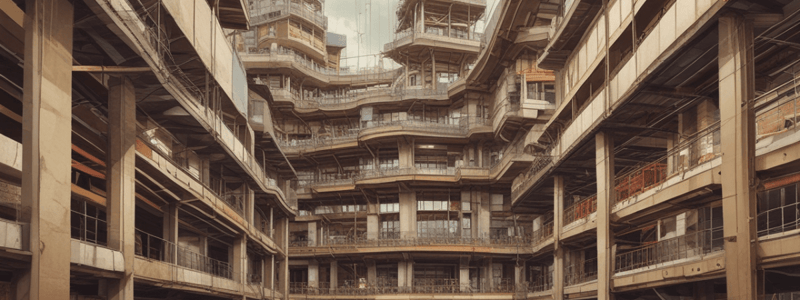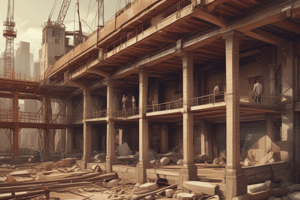Podcast
Questions and Answers
What is the primary reason why clay bricks are widely used in construction?
What is the primary reason why clay bricks are widely used in construction?
- Because they are highly durable and expensive
- Because they are only used for exterior walls
- Because they are economical and easily available (correct)
- Because they are difficult to handle and work with
What is the minimum crushing strength of a first-class brick?
What is the minimum crushing strength of a first-class brick?
- 10 N/mm2 (correct)
- 15 N/mm2
- 5 N/mm2
- 8 N/mm2
What is the acceptable water absorption percentage for a first-class brick?
What is the acceptable water absorption percentage for a first-class brick?
- 15-18% of its dry weight
- 12-15% of its dry weight (correct)
- 10-12% of its dry weight
- 8-10% of its dry weight
What is the characteristic of the surface of a first-class brick?
What is the characteristic of the surface of a first-class brick?
What is the significance of the sound produced when two bricks are struck against each other?
What is the significance of the sound produced when two bricks are struck against each other?
What is the characteristic of the fractured surface of a first-class brick?
What is the characteristic of the fractured surface of a first-class brick?
What is the primary purpose of classifying clay bricks?
What is the primary purpose of classifying clay bricks?
What is the typical colour of a first-class brick?
What is the typical colour of a first-class brick?
What is the minimum time required for immersing a brick in cold water to test its water absorption?
What is the minimum time required for immersing a brick in cold water to test its water absorption?
What is the primary factor that affects the compressive strength of clay bricks?
What is the primary factor that affects the compressive strength of clay bricks?
What is the maximum allowable absorption by 5-hour boiling according to ASTM C67?
What is the maximum allowable absorption by 5-hour boiling according to ASTM C67?
What type of brick is used for all load bearing structures?
What type of brick is used for all load bearing structures?
What is the primary characteristic of Facing Bricks?
What is the primary characteristic of Facing Bricks?
What is the texture of Sand-Faced Brick?
What is the texture of Sand-Faced Brick?
What type of brick is obtained from the outer portion of the kiln?
What type of brick is obtained from the outer portion of the kiln?
What is the purpose of Common Bricks?
What is the purpose of Common Bricks?
What is the characteristic of Rustic Brick?
What is the characteristic of Rustic Brick?
What is the standard that governs the physical requirements for clay building bricks?
What is the standard that governs the physical requirements for clay building bricks?
What is the primary reason for mixing clays from different sources and locations in the pit?
What is the primary reason for mixing clays from different sources and locations in the pit?
What happens to clay particles when subjected to appropriate temperatures?
What happens to clay particles when subjected to appropriate temperatures?
What is the main difference between surface clays and fire clays?
What is the main difference between surface clays and fire clays?
Why do bricks from different manufacturers that have the same appearance differ in other properties?
Why do bricks from different manufacturers that have the same appearance differ in other properties?
What is the primary characteristic of shales?
What is the primary characteristic of shales?
What is the purpose of clay having wet and air-dried strength?
What is the purpose of clay having wet and air-dried strength?
What is the common composition of all three types of clay?
What is the common composition of all three types of clay?
What is the main difference between surface clays and shales?
What is the main difference between surface clays and shales?
Why do bricks from the same manufacturer have slightly different properties in subsequent production runs?
Why do bricks from the same manufacturer have slightly different properties in subsequent production runs?
What is the primary purpose of blending raw materials in the manufacturing process?
What is the primary purpose of blending raw materials in the manufacturing process?
What is the primary function of inclined vibrating screens in the preparation phase?
What is the primary function of inclined vibrating screens in the preparation phase?
What is the range of water percentage mixed into the clay to produce plasticity in the stiff-mud process?
What is the range of water percentage mixed into the clay to produce plasticity in the stiff-mud process?
What is the first step in the forming process?
What is the first step in the forming process?
What is the purpose of storing sufficient quantities of raw materials?
What is the purpose of storing sufficient quantities of raw materials?
What is the name of the machine used to break up large clay lumps and stones?
What is the name of the machine used to break up large clay lumps and stones?
What is the primary function of a pug mill?
What is the primary function of a pug mill?
How many principal processes are there for forming brick?
How many principal processes are there for forming brick?
What is the final phase of the manufacturing process?
What is the final phase of the manufacturing process?
What is the primary function of the final drying stage in a tunnel kiln?
What is the primary function of the final drying stage in a tunnel kiln?
What is the temperature range for the dehydration stage in a tunnel kiln?
What is the temperature range for the dehydration stage in a tunnel kiln?
What is the primary cause of disintegration in bricks due to excess lime?
What is the primary cause of disintegration in bricks due to excess lime?
Why are pebbles, gravels, and grits considered harmful substances in brick manufacturing?
Why are pebbles, gravels, and grits considered harmful substances in brick manufacturing?
What is the primary effect of organic matter on bricks during burning?
What is the primary effect of organic matter on bricks during burning?
What is the role of alkalis in brick manufacturing when present in small amounts?
What is the role of alkalis in brick manufacturing when present in small amounts?
What is the primary purpose of the cooling stage in brick manufacturing?
What is the primary purpose of the cooling stage in brick manufacturing?
What is the typical cooling time for bricks in a tunnel kiln?
What is the typical cooling time for bricks in a tunnel kiln?
What is the process of unloading a kiln or kiln car after the brick have cooled?
What is the process of unloading a kiln or kiln car after the brick have cooled?
Flashcards are hidden until you start studying
Study Notes
Bricks
- Bricks are a popular and leading construction material due to their affordability, durability, and ease of handling.
- Clay bricks are commonly used for building exterior and interior walls, partitions, piers, footings, and other load-bearing structures.
- Bricks can be made of burnt clay, a mixture of sand and lime, or Portland cement concrete.
Classification of Bricks
- Based on field practice: • First-class bricks: thoroughly burnt, deep red, cherry or copper color, smooth surface, free from flaws, and have a uniform texture. • Second-class to fourth-class bricks: classified based on physical and mechanical properties.
Physical Requirements for Clay Building Bricks (ASTM C62)
- Compressive strength: not less than 10 N/mm2.
- Water absorption: 12-15% of its dry weight when immersed in cold water for 24 hours.
Classification of Bricks Based on Use
- Common bricks: general-purpose units, manufactured economically, used for filling, backing, and in walls where appearance is not important.
- Facing bricks: made for good appearance, durable, and used in fronts of building walls for a pleasing appearance.
- Engineering bricks: strong, impermeable, smooth, table-molded, hard, and conform to defined limits of absorption and strength.
Classification of Bricks Based on Finish
- Sand-faced bricks: textured surface manufactured by sprinkling sand on the inner surfaces of the mold.
- Rustic bricks: mechanically textured finish, varying in pattern.
Classification of Bricks Based on Burning
- Pale bricks: under-burnt bricks obtained from the outer portion of the kiln.
- Body bricks: well-burnt bricks occupying the central portion of the kiln.
- Arch bricks: over-burnt bricks, also known as clinker bricks, obtained from the inner portion of the kiln.
Types of Clay
- Surface clays: found near the surface of the earth, used for brick manufacturing.
- Shales: clays subjected to high pressures, nearly hardened into slate.
- Fire clays: usually mined at deeper levels, refractory qualities, and used for brick manufacturing.
Phases of Manufacturing
- Mining and storage of raw materials.
- Preparing raw materials.
- Forming the brick.
- Drying.
- Firing and cooling.
- De-hacking and storing finished products.
Manufacturing Process
- Mining: surface clays, shales, and some fire clays are mined in open pits with power equipment.
- Preparation: breaking up large clay lumps and stones, and mixing the raw material.
- Forming: tempering, producing a homogeneous, plastic clay mass, and then forming the brick using stiff-mud, soft-mud, or dry-press processes.
- Firing: tunnel kiln or periodic kiln, divided into five general stages: final drying, dehydration, oxidation, vitrification, and flashing or reduction firing.
- Cooling: important stage, as the rate of cooling has a direct effect on color.
- De-hacking: unloading the kiln or kiln car after the brick has cooled.
Harmful Substances in Bricks
- Lime: excess lime can change the color of the brick from red to yellow and cause disintegration.
- Pebbles, gravels, grits: can spoil the appearance of the brick and cause cracking.
- Organic matter: can make the brick porous, increase water absorption, and reduce strength.
- Alkalis (alkaline salts): can be beneficial as fluxes, but excess can make the clay unsuitable for bricks.
Studying That Suits You
Use AI to generate personalized quizzes and flashcards to suit your learning preferences.




